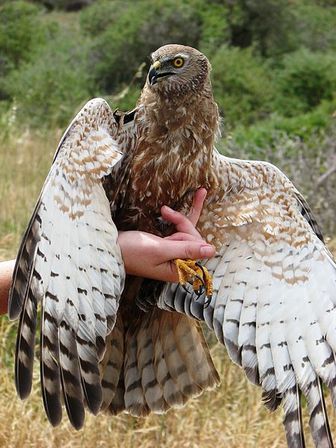African Marsh Harrier
The adult is 45 to 50 cm long and is mostly brown with pale streaking on the head, breast and forewing and rufous on the thighs and belly. Males and females are similar, unlike most harriers. The juvenile is dark brown with a pale breastband and pale markings on the head. The tail and flight feathers have dark barring at all ages. It is usually silent but has a high-pitched, two-note display call.

Original source: Robert E. Simmons, FitzPatrick Institute
Author: Robert E. Simmons, FitzPatrick Institute
Permission: GNU Free Documentation License
The African Marsh Harrier is classified as Least Concern. Does not qualify for a more at risk category. Widespread and abundant taxa are included in this category.
The African Marsh Harrier (Circus ranivorus) is a bird of prey belonging to the harrier genus Circus. It is found in southern, central and eastern Africa from South Africa north to Sudan with a vagrant record from Nigeria. It is particularly common in the Okavango Delta in Botswana. It is usually found in wetland areas, especially those with reeds, but also occurs in grassland and farmland. More
Images previous African marsh harrier imageAfrican marsh harrier © Nigel J. Dennis / www.nhpa.co. More
African marsh harrier in flight African marsh harrier in flightPrint factsheet Facts - French: Busard Grenouillard Kingdom Animalia Phylum Chordata Class Aves Order Falconiformes Family Accipitridae Genus Circus (1) Size More
Distribution of African marsh harrier in southern Africa, based on statistical smoothing of the records from first SA Bird Atlas Project (© Animal Demography unit, University of Cape Town; smoothing by Birgit Erni and Francesca Little). Colours range from dark blue (most common) through to yellow (least common). See here for the latest distribution from the SABAP2. Movements and migrations Breeding adults are largely sedentary, although juveniles may travel far from their parent's territory once they become independent. More
Aspects of the topic "South African marsh harrier" are discussed in the following places at Britannica Assorted References * description and range (in harrier (bird)) ...cinereous harrier (C. cinereus), found from Peru to the Straits of Magellan; the long-winged harrier (C. buffoni), ranging over all of South America, especially east of the Andes; the South African marsh harrier (C. More
The graceful African marsh harrier can be seen as it flies slowly over veld marshland. Both the scientific and Afrikaans names indicate that this bird is fond of eating frogs. Other names: Afrikaans - Afrikaanse paddavreter : Photographer: EcoTravel Africa Apart from eating frogs, the African marsh harrier feeds on small animals such as rodents, birds as well as their eggs and they also eat carrion. More
African Marsh Harriers forages between 1-3 m high over many types of reeds, phragmites and floodplain grassland vegetation. They fly between 20 km/hr and 29 km/hr depending on wind strength (slower in stronger wind). As the smallest marsh harrier, the bird is a buoyant flier, with a typical flap-sailing flight, occasionally interspersed with hovering if prey is sensed. More
Family : Accipitridae
Genus : Circus
Species : ranivorus
Authority : (Daudin, 1800)

